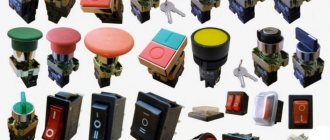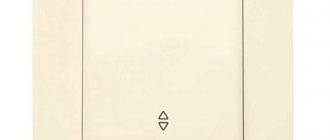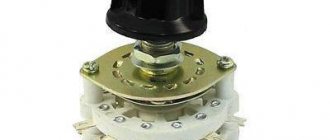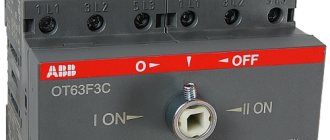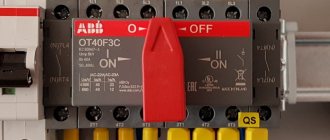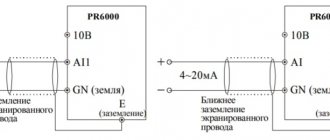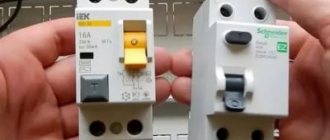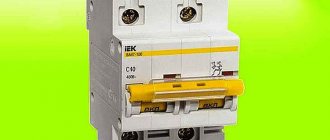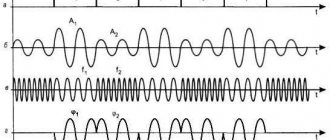Very often you have to turn lighting on and off from several points. For example, in long corridors, on stairs, in basements. You can ensure independent switching on and off of lighting fixtures from 2 remote points using 2 pass-through switches, and in combination with a cross switch, you can control lighting from 3 or more points. The main thing is the correct connection diagram.
- 2 What is the cross switch used for?
- 3 Types of switches
3.1 Keyboards
3.1.1 Differences between regular, pass-through and cross single-key switches (photo gallery)
- 3.2.1 Appearance of rotary switches (photo gallery)
- 3.4.1 Main characteristics
- 4.1 Sequence of actions
Principle of operation
Walk-through switches are no different in appearance from conventional key switches - their design and principle of operation have their own specifics. The main differences between these switching devices are the number and order of connection of the switching contacts.
Please note: When a conventional single light switch is triggered, the phase circuit in which the switching device is connected is simply closed or opened.
When operating 2-pass switches, the order of breaking and closing the chain supplying phase voltage to the lighting device is more complex and branched. During the switching process, two such switches, the diagram of which is discussed below, close one of the connecting lines while simultaneously opening the other.
Electrical switches: multi-contact, scope of application and types
Use transition devices in all similar situations. This is especially true in large offices, hotels and other similar buildings.
Expert opinion
It-Technology, Electrical power and electronics specialist
Ask questions to the “Specialist for modernization of energy generation systems”
What is a pass-through switch and where are they used? To choose the optimal one, you should take into account the type of problem being solved, the required method of controlling the mechanism, and the parameters of the existing electrical circuit. Ask, I'm in touch!
Connection diagrams
The order of connecting devices included in the remote control system is determined by the switching features of the pass-through switches. Let's take a closer look at the principle of their operation.
Electrical diagram
The operating procedure of the system under consideration is most conveniently explained if we use the electrical diagram for connecting a single-key pass-through switch.
According to this figure, the pass-through switches are connected by two linear conductors connecting the switching points. In this case, their changeover contacts are initially in opposite positions and connected to unused linear wires.
Upon entering the room, the switch plate of the first device is moved to a position in which the power supply circuit of the illuminator is closed. As a result of this, it turns on. At the exit of the room, the key of the second single-key switch is switched to the “Off” position, so that the previously formed power circuit is interrupted and the light goes out.
Experts advise, even before connecting the pass-through switches, the diagram of which is discussed above, to specifically provide two points for their placement in the apartment.
Installation diagram with distribution box
By using a standard distribution box, indicated in the figure as a circle, it is possible to electrically disconnect the individual conductors of a system of two switching devices. In this diagram, blue and yellow colors show the conductors that supply zero and phase to the light bulb, respectively, and black colors show the internal switching chains.
We invite you to watch a video on how to connect two pass-through switches without a distribution box:
What kind of lighting do you prefer?
Built-in Chandelier
Installation instructions
Installation work is carried out in the following sequence:
- We lay and fix a two-core wire for connecting pass-through switches.
- We leave a small loop in the area where the cross switch is installed, but do not cut off the wire.
- We mount the switches in the desired places.
- We bring the ends of the conductors to the pass-through devices - two-wire, zero or phase.
- We test the network for the ability to control from two points.
- Turn off the power supply to the network.
- At the installation site of the crossover device, I will cut the two-core cable. We put a cross switch in the gap.
- We supply power.
- We check the network for operability with three control points.
For a cross-pass switch installed indoors, any insulated two-core cable with a cross-section appropriate for the load is suitable. For street lighting, double insulated conductors are used.
Source: 220.guru
Operating principle
To understand what a switch is, you need to consider the principle of its operation and purpose. The device serves to redirect the flow of electricity to another circuit - one circuit is disconnected and the other is closed at the same time. Therefore, the minimum number of contacts for such a device is three. For mechanisms with two or more “keys” the number doubles.
A switch is a switch between electrical conductors of reverse voltage. Purpose – control of one light source from different places. Mainly used for premises with a large area, for example, stadiums, production workshops or warehouses.
Expert opinion
It-Technology, Electrical power and electronics specialist
Ask questions to the “Specialist for modernization of energy generation systems”
Cross switch design: principle of operation and connection (installation) diagram, types, functions, do-it-yourself installation It is especially easy for an inexperienced master to get confused in the connections of wires in the junction box, because their number grows in proportion to the number of switches used. Ask, I'm in touch!
How to avoid 5 installation mistakes
There are mistakes that inexperienced electricians make when laying and connecting wires:
- The neutral wire is connected to the first switch. Before connecting, you should use a tester to find the phase wire.
- Instead of a pass-through switch, an intermediate switch with two changeover contacts and jumpers is installed. This is a valid option, but such devices are more expensive.
- Use instead of special conventional switches. This scheme will not work. You need to take the necessary devices.
- Incorrect wire connection. Before starting work, draw a connection diagram and mark the wires.
- Strip the ends of wires that are not long enough. Such ends do not hold well and fall out of the terminal. They should be stripped to a length of 8mm.
Types of devices
There are several switch options. To select the optimal one, you should take into account the type of problem being solved, the required method of controlling the mechanism, and the parameters of the existing electrical circuit.
By controlling and moving the toggle switch, the following types are distinguished:
Angular devices of both types differ in the ability of the toggle switch to be in two fixed positions. Shifting the handle allows you to move the moving contact from one circuit to another. The movement of direct and alternating currents is redirected.
For toggle switches, different connection schemes are used. There are no restrictions; the final option depends on the needs of the room and the imagination of the electrician.
Maximum load – 6 Amperes. In this case, a small level of resistance is observed (no more than 0.02 Ohm). The reliability of such equipment is determined by the number of possible switchings (the average number is 10,000 times).
Additional classification – by keys. There are three main types:
More keys are acceptable, but not safe. Each has three contacts. If there are too many “jumpers”, a short circuit and burnout of the circuit is inevitable.
The difference between the pass-through and cross-switch is the number of working electrodes. In the first case there are three contacts, in the second there are two each for the input and output of the electrical circuit. Intermediate ones are used to control several light sources, rather than just one.
Specifications
You can buy a crossover switch at any electrical store; the price depends on the model and manufacturer. Let's look at the characteristics of several well-known switches.
ABB Basic 55 white:
| Rated mains voltage, V | 220-250 |
| Maximum permissible current, A | 10 |
| frequency Hz | 50 |
| Contacts | Silver plated, resistant to moisture and steam |
| Frame | Thermoplastic |
| Price | From 10 USD e. |
Cross Schneider Electric SDN:
| Voltage, V | 250 |
| Current, A | 10 |
| Rated power, W | 2300 |
| Protection | IP20 |
| Cost, y. e. | From 3 |
Legrand Valena (its analogue Anam):
| Type | Single-key |
| Maximum voltage in AC mains, V | 230 |
| Current, A | 10 |
| Material | Polycarbonate |
| frequency Hz | 50–60 |
| Cost, y. e. | From 4 |
Viko Carmen (in terms of characteristics and price, Viko has a Chinese equivalent - Makel):
| Allowable voltage, V | 220–250 |
| Current, A | 10 |
| Material | Plastic |
| Design | Built-in two-key |
| Price | From 1.00 e. |
Lezard Nata:
| Mains voltage, V | 220 |
| Current, A | 10 |
| Type | Single-key overhead |
| frequency Hz | 50 |
| Material | Plastic |
| Price, y. e. | From 3 |
Types of pass-through switches and symbols on diagrams
Depending on how and where you plan to use such switches, their corresponding varieties will be used:
For installation in the thickness of the wall and on its surface - in the second case, such switches are most often used for open wiring in wooden houses.
Wires to the switch terminals can be secured with bolted connections or spring clamps. The second option is considered more preferable, since its use does not weaken the connection over time.
You can turn on several lamps from one place - for this they make double, triple, etc. switch models.
If there is a need to turn on lighting from three or more points, then for two walk-through points it is necessary to additionally purchase crossover (reversible) switches - according to the number of places from which the lighting will need to be turned on.
The type of control does not differ from conventional ones - they can be keyboard, touch, or with a remote control.
All types of pass-through switches in the diagrams are drawn with the same schematic designation - essentially the same as for standard ones, but turned in both directions.
In order to make the final choice, you need to understand exactly where and how these switches will be used.
Electronic devices
When considering the option of controlling a lamp from 4 places at once, two cross switching devices will be required.
Expert opinion
It-Technology, Electrical power and electronics specialist
Ask questions to the “Specialist for modernization of energy generation systems”
Conclusions To create a multi-point control system that allows you to connect and turn off lights from 3 places at the same time, installing pass-through switches alone is usually not enough. Ask, I'm in touch!
Cross Switch Design
The device itself for inversion switching of power lines is simple. However, due to the multi-point circuitry characteristic of such devices, implementation difficulties can become real. Therefore, it is logical to consider the design of the device, as well as the connection diagrams.
The purpose of the communicator is obvious - connecting electrical circuits for household (commercial) purposes, where the voltage level does not exceed 250 volts. The standard design of the devices is designed for operation inside dry, warm rooms that meet the established protection class standard (IP20).
Externally, it does not differ in any way from traditional designs of light switching devices. However, the internal reversing switch system has a slightly different circuit design.
The installation of cross switches is carried out in the traditional way (similar to the installation of a conventional light switch) with fastening the mounting box with screws, or internal installation is done with fastening the base to the wall with metal claws.
The body of the device is usually made of impact-resistant, non-flammable technopolymer. All structural parts for outdoor installation are resistant to ultraviolet radiation.
Products of modern design are distinguished by the use of high-quality materials for external framing. Technical plastic is not affected by ultraviolet and light rays
The mechanics of crossover switches for a current of 10A are equipped with quick-release contact groups. The mechanics of devices for a current of 16A have screw terminals. For ease of connection, the terminals (phase and neutral) are usually marked in different colors.
The switch terminals are designed for connecting conductors made using single-core or multi-core pulling technology. Cross-section of single-core conductors up to 2.5 mm2, multi-core up to 4 mm2 (for 16A switches).
